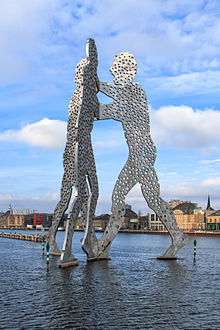Jonathan Borofsky
Jonathan Borofsky | |
|---|---|
 | |
| Born | 1942 |
| Nationality | American |
| Education | Carnegie Mellon University Yale University |
| Known for | Painting, Sculpture, Installation art |
Jonathan Borofsky (born December 24, 1942) is an American sculptor and printmaker who lives and works in Ogunquit, Maine.[1]
Early life and education
Borofsky was born in Boston, Massachusetts. He received his Bachelor of Fine Arts at Carnegie Mellon University in 1964, after which he continued his studies at France's Ecole de Fontainebleau and received his Master of Fine Arts from Yale University in 1966. He lived in Manhattan until a teaching position at the California Institute of the Arts brought him to Los Angeles in 1977. He resided in Venice[2] and Tuna Canyon,[3] Los Angeles from 1977 to 1992,[4] In the 1960s, Borofsky's art sought to interconnect minimalism and pop art.
On May 21, 2006, Borofsky received an honorary doctorate in Fine Arts from Carnegie Mellon, his alma mater.
Works
Jonathan Borofsky's most famous works, at least among the general public, are his Hammering Man sculptures. "Hammering Men" have been installed in various cities around the world. The largest Hammering Man is in Seoul, Korea and the second largest is in Frankfurt, Germany. Other Hammering Men are in Basel, Switzerland, Yorkshire Sculpture Park, Dallas, Denver, Los Angeles, Minneapolis, New York City, Seattle, Gainesville, FL, Washington, D.C. and Lillestrøm, Norway.
Commissioned by developer Harlan Lee, Borofsky’s 30-foot-tall sculpture Ballerina Clown was erected above the entrance to a drug store in a mixed use, residential and commercial building in Venice, California in 1989. It was motorized so that its right leg would perpetually kick until tenant complaints were lodged about mechanical noise.[5] In 1990, the Newport Harbor Art Museum commissioned Ruby, a 5-foot-tall plastic sculpture containing an internal lighting system and swaying, diamond-shaped light deflectors.[6]
In 1999, three of his Molecule Man sculptures, standing 100 feet tall, were set directly into the Spree River in Berlin as a commission for German insurance company Allianz.[7]
In 2004, the City of Baltimore, through its public arts program, commissioned Jonathan Borofsky to create a sculpture as the centerpiece of a re-designed plaza in front of Penn Station. The work is a 51-foot (15.5 m)-tall aluminum statue titled "Male/Female." For information on the controversy generated by Borofsky's Male/Female sculpture, see "Pennsylvania Station (Baltimore)"Pennsylvania Station (Baltimore).
In May 2006, Borofsky's "Walking to the Sky"[8] was permanently installed on the campus of Carnegie Mellon University near the intersection of Forbes Avenue and Morewood Avenue in Pittsburgh. The piece was temporarily installed at Rockefeller Center during the fall of 2004 and in 2005 at the Nasher Sculpture Center in Dallas, Texas.
Major permanent commissions
- "Walking to the Sky" (2006). Pittsburgh.
- "Male/Female" (2004). Baltimore.
- "Walking Man" (1995). Munich.
- "Ballerina Clown" (1989). Los Angeles.
Selected exhibitions
- 2004 - Rockefeller Center, New York City
- 2002 - Fondazione Sandretto Re Rebaudengo, Cuneo, Italy
- 1999 - Kunstmuseum Basel; Remba Gallery, Los Angeles
- 1996 - Whitney Museum of American Art, New York City
- 1992 - Documenta 9, Kassel
- 1987 - Documenta 8, Kassel
- 1985 - Berkeley Art Museum, Berkeley, California
- 1984 - Stadel, Frankfurt
- 1982 - Documenta 7, Kassel
- 1981 - Contemporary Arts Museum, Houston, Texas
Gallery
-
"Human Structures" at "blickachsen 7", 2009
-
Hammering Man in Frankfurt
-
Man walking to the sky, Kassel
References
- ^ Hunter Drohojowska-Philp (October 24, 1999), Living Outside His Own Shell Los Angeles Times.
- ^ Cathy Curtis (December 13, 1990), Art Museum Gets Borofsky's 'Ruby' Work Los Angeles Times.
- ^ Kristine McKenna (July 30, 1989), Why Jonathan Borofsky Bowed Out: 'I needed to be alone with myself and find out what was left of my art.' Los Angeles Times.
- ^ Hunter Drohojowska-Philp (October 24, 1999), Living Outside His Own Shell Los Angeles Times.
- ^ Christopher Knight (May 20, 2014), Jonathan Borofsky's 'Ballerina Clown' in Venice dances again Los Angeles Times.
- ^ Cathy Curtis (December 13, 1990), Art Museum Gets Borofsky's 'Ruby' Work Los Angeles Times.
- ^ Hunter Drohojowska-Philp (October 24, 1999), Living Outside His Own Shell Los Angeles Times.
- ^ Publicartfund.org
Sources
External links
- Borofsky's website, borofsky.com
- Art Signature Dictionary, genuine signature by the artist Jonathan Borofsky Here are several examples of Jonathan Borofsky's signature.
- 20th-century American sculptors
- 21st-century American sculptors
- American male sculptors
- Contemporary sculptors
- American contemporary artists
- American printmakers
- Sculptures by Jonathan Borofsky
- 1942 births
- Living people
- Carnegie Mellon University College of Fine Arts alumni
- Yale University alumni
- ROIR artists
- 20th-century American artists
- 21st-century American artists




